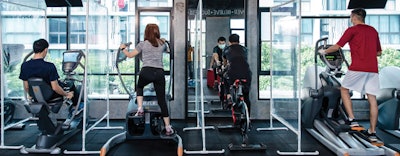
While all industries have been disrupted in some way by the coronavirus pandemic, perhaps none has been hit harder than the fitness industry. Between months of mandated closures, public fights over reopening and members being slow to return (if they do at all), fitness facilities are facing unprecedented hurdles as they pursue something resembling business as usual.
The data showed that for the 49.4 million check-ins during the survey period, only 1,155 cases were reported — a visit-to-virus ratio of .0023 percent. Notably, the report claims that none of the cases had been contracted within a fitness facility. |
Still, there are those in the industry who are fighting every day — not just to remove restrictions on gyms and fitness facilities — but to assure members that the fitness facilities to which they belong are capable of providing a safe environment.
The International Health, Racquet and Sportsclub Association, which represents thousands of fitness facilities worldwide, recently released a report in partnership with MXM, a firm focused on member experience management in the fitness industry. The two organizations tracked member check-in data from 2,873 participating fitness facilities and compared that figure to the total number of COVID-19 cases involving a club member or employee. The data showed that for the 49.4 million check-ins during the survey period, only 1,155 cases were reported — a visit-to-virus ratio of .0023 percent. Notably, the report claims that none of the cases had been contracted within a fitness facility.
IHRSA hopes that data will help to push governments toward reopening — and help convince members to return.
Industry advocacy
IHRSA interim president and CEO Brent Darden told AB that the association is focused on providing information to help clubs better advocate for themselves.
"I would say that we're trying to be the mouthpiece for members of the association," Darden says. "The strategy really is, let's get the message out to the people who are on the front lines, all the different clubs, so that they can get the message out locally through the social media channels that they have, the connections that they have, and all the advertising and promotional things that they're doing. We've seen that be really effective in many, many cases."
The association employs lobbyists at both the state and federal levels, and is encouraging cooperation among various segments of the industry to form state-level "alliances."
"It's very inclusive, meaning it's for-profit clubs, it's non-profit clubs, it's independent operators, it's really big players, it's boutiques, it's CrossFit, it's martial arts studios, it's yoga studios, Pilates studios, cycling studios," Darden says of the state alliances, which he says number 18 in total. "They're joining these alliances really so they can have a voice at the highest level in their states with their government and with their health departments.
"We've really been trying to support those alliances because they're out there literally on the front lines, state to state, and so we've been giving them toolkits and templates and message points and organizational documents so we can help them grow very quickly."
Well-positioned for reopening
Darden argues that, for a number of reasons, health clubs may actually be some of the facilities best equipped to handle a global pandemic. And as we gain a better understanding of the virus and how it spreads, he thinks gyms come out looking even better. "Early on, everything was all about the surfaces," says Darden. "It was all about keeping surfaces clean. And that dialogue from the experts in the medical community has really changed. It's really about your expiration — it's really about droplets and transmission through the air."
With that understanding, clubs have been able to focus on physical distancing and air exchange rates. "Most clubs are already set up with a really high rate of exchange of air quality, and have been for a while because that's sort of the way their HVAC systems were set up," Darden says. "Secondly, in most clubs, there's space to distance people."
Even in the unlikely event that an outbreak were to happen at a club, Darden believes that check-in procedures at most facilities provide operators with another argument in favor of reopening: the ability to use check-ins for contact tracing.
"We have already in place mechanisms for contact tracing, which are inherent in the way we do business," Darden says. "We know who's coming and going. We can control the flow of traffic, if you will. So, really health clubs, when you break it down, have a lot of things going for them that the experts out there say really should be taken into consideration about opening and closing."
Ultimately, Darden says that the industry's push to reopen is rooted in the reason for its existence: to provide members with the means to achieve and maintain their personal health. "At a really genuine, higher level, we want to help be part of the solution to reverse the epidemic of obesity, the epidemic of inactivity, and the lack of well-being in our society."
You can hear our full conversation with Brent Darden on a recent episode of The Athletic Business Podcast. Subscribe to the show on your preferred podcast platform.
This article originally appeared in the November|December 2020 issue of Athletic Business with the title "IHRSA president weighs in on industry's push to combat COVID fears." Athletic Business is a free magazine for professionals in the athletic, fitness and recreation industry. Click here to subscribe.

































